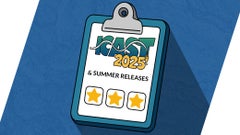Kevin VanDam Wins BASS Toledo Bend
Kevin VanDam's Winning Pattern, Baits & Gear
"You heard a lot of 'What's wrong with KVD?' and now, after (Sunday), it's 'KVD's back,''' he said. "Well, in my mind, I never went anywhere. These things cycle. "One thing I can tell you is the more experience you have, the harder it is to keep an open mind. You have a better chance to utilize that experience and draw from it, but it can be a hindrance, and that line is very fine. I think you could ask anybody who's been around for 10-plus years and they'll say that history can bite you, and I've had that happen to me." History didn't play much of a role last week at Toledo Bend Reservoir, where he won the fifth event of the Elite Series campaign with a 4-day total of 96-02. The water was higher than it had ever been for a top-level tournament there, which brought a lot of shoreline vegetation into play at a time of year when it's normally not a major factor. A lot of high finishers exploited the skinny water, but VanDam relied on his Humminbird electronics with Lakemaster mapping to locate the big offshore fish that would carry him to his unprecedented 21st B.A.S.S. victory. He caught the biggest stringer of the derby on day 1 and never let anybody get closer than 2 pounds of his total on any of the succeeding 3 days. His fourth consecutive 20-plus-pound stringer on the final day gave him a winning margin of more than 7 1/2 pounds over runner-up Chris Lane.
VanDam's first priority when practice opened was to seek out bass keying on the shad spawn. He'd finished 19th in the previous Elite Series visit to the big impoundment on the Texas-Louisiana border, and that was a big part of his program on that occasion. "I wanted to get out and look for that early in the mornings," he said. "We had a good bit of wind, but in the mornings it was okay - it wasn't super-rough. I found some shad, but I didn't find many bass and it was really kind of perplexing. "The last morning I caught a few off of docks and seawalls and things like that, but normally it's happening round the hay grass and cypress trees. I found more on the deeper docks, where (the shad) were spawning on the pilings." He spent the rest of his practice days exploring deeper water despite the difficult conditions. "I didn't catch a lot of fish out there in practice because it got so windy that you really couldn't fish offshore. It was so rough that you could hardly idle places without taking waves over the front. I did catch a few good ones out there, so I knew it was viable, but in every instance I never found a school - I'd always make the next cast after catching one and I never caught two in a row. They were fish that were just transitioning from the mid-range to the deeper areas. "After practice, I didn't have any huge expectations even though I had a couple places I'd gotten good bites on. I knew I'd have to try to catch some early on the shad spawn, but I still thought the pickings would be pretty slim out deep for me." A big key - just as it was for Takahiro Omori 2 weeks earlier at Wheeler Lake - was that nobody else had located the offshore fish he'd exploit over the next 4 days.
Competition:
VanDam started day 1 on a point where he'd caught a couple of shad-feasting keepers in practice and put together a 14-pound limit in about 15 minutes. It consisted of a 5-pounder and four that averaged 2 1/4 apiece. With the surface of the water in a calm state, he moved to a deep-water hump that had produced a 6-pounder in practice on a Strike King 10XD crankbait. He popped a 5-pounder on his first cast, and another a few minutes later. After a half-hour, he'd boxed four that were all in the 4 1/2- to 6-pound range. "They were all on top of this hump, kind of scattered around," he said. "What's very different about Toledo Bend compared to Kentucky Lake or places like that is for those Tennessee River fish, current is their whole world, whereas at Toledo Bend, there's times when they're generating water and there's current there, but a lot of it has to do with wind. "It's tricky following the Toledo Bend fish from day to day because even though the current varies, it's never nearly as strong as it is on the Tennessee River. That makes the bass very nomadic and they follow the schools of gizzard shad and threadfin shad and the yellow bass."
He had 25 pounds in his livewell at that point, so he opted to search for more deep-water haunts for the remainder of the day. It was a highly productive quest as he culled up three times with a 5 1/2-pounder, a 6 and a bruiser in excess of 8. His haul was the biggest of the derby by almost 4 pounds. The wind changed directions and came out of the north on day 2, and it stiffened up considerably. His shad-spawn tactic produced just one run-of-the-mill keeper on a topwater offering, and he relocated to an offshore locale where he'd gotten one good bite in practice. It gave him a 7-07 brute on the 10XD and a near-5-pounder on a swimbait. He caught perhaps 40 additional keepers from several spots through the rest of the day, but none were much over 3 pounds and he took three of those, along with his two bigger specimens, to the scale. He saw his lead reduced from more than 4 1/2 pounds to just over 2 as Lane had come in with just slightly less than 24 pounds for the second straight day. He re-established his firm lead the following day when he caught 25 pounds (he was penalized 4 ounces after a fish that had been hooked in the tongue expired). He boated an early 4 1/2-pounder on a Strike King KVD Sexy Dawg topwater, then went to the place that had produced dozens of keepers the day before, but failed to get a single bite.
Finally, he got a 6XD hung up in a tree top and got a bite when he popped it loose. The fish was an 8 3/4-pound giant. He ran some other points and caught a 2 1/2-pounder and a 5, but still had only four fish at 1 o'clock when he lost a 12-inch spotted bass at the boat. In the last 20 minutes, he caught another 5-pounder to complete his limit. "I literally only boated five keepers that day," he said. "It was a great bag, but it took an all-day grind to get it." He took a lead of 5 3/4 pounds into the final day and picked up a quick 4-pounder and a small keeper on the topwater. He transitioned to his cranking program and caught three keepers to give him a limit. The wind calmed down at about 11 o'clock and his best action each day was always after that hour. He completed his bag with 7- and 4-pound culls in the early afternoon. "I felt pretty good because I knew I had over 20 pounds," he said. "You always want to catch more, and when you look back at 96 pounds you say, man, he was just killing them, but I had 2 days when it was a real struggle to get bites."
Winning Pattern:
VanDam said he graphed most of his offshore places before fishing them each time and knew where the bass were sitting. "You had to make specific casts based on where they were to trigger them," he said. "It wasn't like you could just randomly cast around." He caught fish from depths ranging from 15 to 30 feet utilizing three XD crankbaits. He employed the 6XD from 15 to 19 feet and the 8XD from 18 to 22. "The 10XD is just a big-fish bait and I threw it everywhere." He threw both rattling and non-rattling crankbaits. "I always start with rattling and then go to silent. I learned a long time ago that there are days when you have to throw both."
His HydroWave unit was operating constantly when he was on the front deck. "I'd run (the Spawning Shad mode) on continuous in the morning and I could see the shad get active when I pulled up. My favorite pattern for ledge-fishing is Delayed Schooling on a 30-second delay at low to mid volume, depending on the wind. It makes the bait nervous and the bass get nervous because they know something's going on and they don't want to miss out on the party."
Winning Gear:
Light cranking gear: 7'10" medium-heavy composite Quantum Tour KVD cranking rod, Quantum Tour KVD casting reel (5.3:1 ratio), 12-pound fluorocarbon line, Strike King 6XD crankbait (sexy blueback herring or bar fish). The bar fish color is an imitation of the yellow bass.
Heavy cranking gear: Same rod (7'11" heavy-action composite), Quantum EXO 200 casting reel (5.3:1 ratio), 14- or 17-pound fluorocarbon, Strike King 6XD or 10XD crankbait (sexy blueback herring). He replaced the stock hooks on the crankbaits with Mustad KVD Elite Triple Grip Trebles (1/0 on the 6XD, 2/0 on the 8XD and 10XD).
Topwater gear: 7'4" medium-heavy Quantum Tour KVD rod, Quantum Tour KVD casting reel (7.3:1 ratio), 17-pound monofilament line, Strike King KVD Splash popper or Strike King Sexy Dawg (blue gizzard shad or chrome sexy shad). He caught one weigh-in fish on a Strike King Rage Swimmer (sight flash) attached to a 3/4-ounce swimbait jighead.
Main factor: "One of the real keys was the wind in practice kept a lot of other people from getting to probe the offshore stuff very much."
Performance edge: "The Lakemaster chip is so good that it's overwhelming - it showed so much good structure to search. It's an amazing job of mapping."
Chris Lane's Pattern, Baits & Gear
Topwater gear: 7'4" medium-heavy titanium rod, casting reel (7.3:1 ratio), 50-pound Stren Braid, River2Sea Dahlberg Whopper Plopper (white) or Zara Spook (white).
Flipping gear: Same rod, reel and line, 1/2-ounce weight, 4/0 Lazer TroKar flipping hook, Luck-E-Strike Drop Dead Craw (Okeechobee craw).
Main factor: "I just kind of followed what the fish were doing throughout the week."
Performance edge: "The Stren braided line, hands down. I was making the hardest, longest casts I could and catching giant fish, and my hooksets were good. I've been using it since before I was sponsored by Stren and it's the best braided line, period."
Ish Monroe's Pattern, Baits & Gear
Flipping gear: 8' heavy-action Daiwa Steez AGS rod, Daiwa Zillion HD casting reel (7.3:1 ratio), 50- or 65-pound Maxima braided line, River2Sea Tommy Biffle Junkyard Jig (black/blue), Missile Baits D Stroyer trailer (black/blue).
Main factor: "Having a clear head and fishing fresh water. I didn't listen to the dock talk that was all about out deep, out deep, out deep, and with a little help from my roommates (John Crews, Mike Iaconelli and Fletcher Shryock), I knew what I needed to be doing."
Performance edge: "The Steez AGS is the most sensitive rod I've ever picked up Ð I can feel everything. There were times when I happed the jig out of the root and a fish would hit it, I could feel the hit on a slack line."
Keith Combs' Pattern, Baits & Gear
Cranking gear: 7' medium-action Power Tackle Keith Combs Signature Series rod, Shimano Curado casting reel (7.3:1 ratio), 15-pound Seaguar InvizX fluorocarbon line, Strike King 6XD crankbait (Tennessee shad). His two Carolina-rig fish were enticed by a Strike King Game Hawg.
Paul Mueller's Pattern, Baits & Gear
Cranking gear: 8' medium-action Dobyns Champion Paul Mueller Signature Series glass rod, Lew's BB1 Pro casting reel (5:1 ratio), 14-pound Gamma Edge flurocarbon line, Strike King 10XD crankbait (citrus shad or spatterback).
Dropshot gear: 7' medium-heavy Dobyns Champion spinning rod, Team Lew's Pro Speed Spin 3000 reel, 15-pound Gamma Torque braided line, 10-pound Gamma Edge fluorocarbon leader (10-12') 4/0 Gamakatsu worm hook with modified keeper, Reins Bubbling Shaker (margarita mutilator), 3/8-ounce Do-It Molds cylindrical dropshot weight.
Main factor: "On the last day, it was keeping an open mind and knowing I was around some big fish."
Performance edge: "Without the Garmin map, I could not have found the place where I caught the three big ones (on day 4). I would've finished in 12th place, for sure."



























